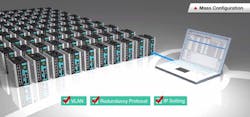6 Tips for Lowering the Cost of Industrial IoT Networks
Companies moving to the Industrial Internet of Things (IIoT) have spawned a parallel growth in the number of connected devices on networks, as well as increasing the scope and complexity of industrial control networks that frequently converge with traditional IT networks. More than ever before, concerns about security, availability, and performance are affecting these industrial control networks.
One consequence of the move to IIoT is that purchasing network devices isn’t the end of the expenditure. In fact, it is often only the beginning. Network operators are discovering a host of associated direct and indirect costs that can often exceed the initial investment in networking hardware.
Let’s look at some of those overlooked costs and some suggestions on how to lower the total cost of ownership (TCO) for industrial control networks.
After purchasing a switch, several factors need to be considered over the switch’s life, including installation, configuration, operations, maintenance, downtime, and ongoing technical support. After taking these six stages into consideration, network administrators can better judge a network’s true TCO and make the right decisions to keep it as low as possible.
Network Challenges
The challenge for administrators is understanding each stage and the key features devices should have, or support that benefits each stage, as well as how beneficial these features will be when the network’s needs change. These features and benefits often don’t appear in a spec sheet but are essential to keep in mind when buying network products. The six stages are discussed below, with scenarios provided to give a fuller understanding of the factors affecting the TCO.
Total Cost of Ownership
After considering some of network challenges, it becomes evident that the costs of commissioning and operating can easily exceed the cost of the components. Here are some ways to reduce TCO by attacking costs in each stage.
This flowchart shows the six stages in a network’s lifecycle. Two of the stages are combined: Integration and Configuration.
Reducing installation costs. It is rare to see a completely brand-new network in an industrial environment. Most networks combine new equipment with upgrades on existing SCADA systems, control networks, and devices. Administrator must be able to choose and deploy the right devices to meet the network’s current and future requirements. A good example of this is ensuring all network devices are compatible throughout the network’s life. Although there are many ways to overcome this challenge, one of the best is to choose devices with the most flexibility.
For industrial networks, devices are often installed in control panels along with other devices that run on different voltages. To deal with that, you can buy a power converter to ensure compatibility. However, this may not be the ideal solution based on the panel’s size or the additional costs incurred from purchasing power converters and cables. For some projects, the cost of new cables adds significantly to the network’s overall costs.
A better approach may be to use devices that support a wide range of power inputs and satisfy the network’s demands. Although the initial expenditure may be slightly higher for a switch that supports these features, costs can be reduced over the network's life by avoiding costs later.
Reducing configuration costs. One of the most time-consuming and expensive tasks is configuring devices on a network so that they secure settings, redundancy, interoperability, and efficient performance. A wide range of options are available, from basic switches that offer no support with configuration all the way up to large, expensive software packages that greatly help in configuring the networks.
This can be compared to using less expensive devices which requires a lot more effort spent on configuring devices later on in the project. As the number of devices on a network increases, so do the possibilities for savings. Here are some of aspects of configuration process with a strong effect on TCO.
With the convergence of industrial automation and IT across IIoT networks, EtherNet/IP and PROFINET protocols must operate together on the same network. Preconfigured devices that let these disparate protocols communicate let administrators install what are essentially plug-n-play devices.
These devices often support automatic discovery and the ability to assign IP addresses which eliminates a significant amount of configuring time. Compare this with using inexpensive devices which require a lot more effort to configured later in the
The multi-protocol capability makes it easier to combine PLCs with a SCADA system.
Configuration costs are not limited to when the network is first set up. Any feature that lets technicians copy and save device configurations lets administrators reuse those settings later and eliminates the need to manually configure new devices added to the network.
Configuration is also easier using an intuitive graphical user interface (GUI). Some companies offer advanced testing kits which let users test the GUI and independently validate whether it is intuitive before installing devices on a network. Intuitive GUIs save network operators a significant amount of time over the life of the network.
Batch configuration is one of the most effective ways to reduce configuration costs. Because the number of networked devices keeps increasing, both time and money can be saved by using mass configuration instead of configuring devices one by one.
Reducing operational costs. A key way to lower operational costs is to design a network that minimizes the amount of manual work needed to keep the switches and network operational. In addition, ensuring devices are suitable for industrial environments helps the network operate at peak efficiency and performance.
The two main weak points on devices in an industrial network are their moving parts and power inputs and requirements. Switches with the fewest moving parts are less likely to malfunction or break, resulting in less network downtime and lower costs.
Similarly, if a device supports dual-power inputs and one power supply fails, the other will keep the device running, letting the faulty supply be replaced without network downtime. For deployments lasting longer than 10 years, which is the norm for IIoT networks, there is a high chance the administrators will see one of these problems during those 10 years.
The majority of IIoT networks are controlled by programmable logic controllers (PLCs). When the network performs scheduled maintenance and performs a reboot, a PLC will often take 20 seconds to reboot. If a PLC boots up before the network is ready to operate, errors can cause further delays. Switches that boot up in 10 seconds as opposed to 100 seconds will be ready to operate as soon as the PLC has rebooted.
Checking out the network’s status at a glance via software or an app is one of the easiest ways to monitor a network. These apps and software sometimes include an alert that warns administrators an event is taking place that could cause a network failure unless rectified. Alerting the administrator that a problem could happen later, as opposed to telling him there’s a problem now, is an excellent way to reduce maintenance costs. These alerts may increase a device’s price, but over the course of the network’s life they will likely result in substantial savings.
Reducing downtime costs. Finding the root cause of a failure on large-networks is time-consuming, so any tools that let administrators quickly identify and fix points of failure and reduce downtime have significant advantages. It’s also helpful if the administrator can calculate whether the additional costs of features that reduce downtime will outweigh the costs of the avoided downtimes.
Devices that can be remotely accessed and configured are beneficial because they let untrained personnel handle the time-consuming task of going to field sites. This lets trained specialists troubleshoot and configure from the control center. In addition, devices that offers playback support lets specialists identify what happened when the network goes down, as well as to improve the network to avoid such failures in the
A tool that replays events to quickly narrow down the possible cause of the network problem is a major benefit.
Devices that back up the switch’s configurations on a dongle are particularly helpful if the switch malfunctions. To import all the “lost” settings, just plug the dongle into the switch. No configurations need to be performed manually, so network downtime is reduced.
As network administrators are not always based in the control room, mobile apps that support event notifications provide network administrators with the ability to respond more quickly to events taking place on the network, letting them get the network back to normal more quickly than would have otherwise been possible.
Self-healing technologies ensure networks stay up-and-running even if there’s a single node failure. Deploying these technologies that allow greater flexibility, availability, and scalability for future network expansion can help avoid future expenditures.
Costs of ongoing technical support. Administrators have a variety of options when purchasing switches, ranging from inexpensive devices with no ongoing support or firmware upgrades, to switches with ongoing technical support that will cost more than the switch. As switches are often used on networks for longer than 10 years, technical support that comes with a switch will significantly affect costs in the long-term.
For example, new security threats are regularly identified, and companies that offer ongoing technical support often release security updates via firmware upgrades to eliminate new cyberthreats. Conversely, when a network device is compromised and there is no ongoing technical support or firmware upgrades, the administrator must replace the device or risk the entire network’s security. Reliable switches with free ongoing technical support complemented by long warranties offer significant advantages for network administrators looking for the lowest TCOs.
After considering the life a network and the hidden costs that can arise during it, it is clear several factors must be considered when determining a network’s direct and indirect costs. It should be noted that administrators can never be 100% sure what an IoT network’s future needs will be. Still, understanding each of the six stages described above ensures that administrators know more about devices with the best chances of lowering the TCO throughout the network’s life.
Richard Wood is product marketing manager, and Vance Chen and Yiwei Chen are product managers, at Moxa Inc. If you have any questions regarding IIoT and networks, please feel free to call the company at 888-669-2872 or e-mail [email protected].





